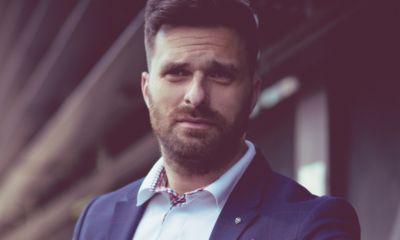Success Advice
Growth Mindset Vs. Fixed Mindset: Which One Do You Have?

I recently finished Carol Dweck’s book “Mindset: The New Psychology of Success,” which motivated me to deeply ponder her thesis on the Growth Mindset versus the Fixed Mindset, and how we, as individuals, employ them in life every day. Mindset (or attitude, as I prefer to call it) is critical because in order to be successful, one must be self-aware of the mindset to which they subscribe.
For example, are you challenging yourself? Are you giving up in the face of adversity or potential failure? Are you putting in deliberate, conscious effort? Are you afraid to take on challenges because of the fear of making a mistake?
According to Dweck, these are the questions one must ask. If you want to be truly successful and achieve mastery, new psychological evidence suggests that hard work, effort, perseverance, and grit are the keys to get you there.
A similar case study was exposed in Malcolm Gladwell’s book, “Outliers: The Story of Success.” Gladwell’s assertion is that 10,000 hours of hard work, struggle, and deliberate practice are needed before one is considered an expert and holds mastery over their field. These notions resonated with me, because I’m sure everyone remembers their father’s, grandfather’s, or a mentor’s advice when they were young and thought they knew it all: “Look son, there are no get-rich-quick schemes in life, if there were, we’d all be rich” or “The road to success is built upon blood, sweat, and tears” (i.e., sweat equity); you get the gist.
I am a true believer that talent, ability, and intellect can only get you so far. One must also possess a strong desire and insatiable hunger to learn and develop by taking challenges head-on and cultivating and advancing skills.
Moreover, new research has challenged conventions in that the brain does in fact continue to develop into your early thirties. Advanced neuroscience indicates that the brain is malleable, and you can influence neurons that can change with experience, either positive or negatively.
When constant positive neural growth takes place, you change your baseline thinking and re-wire thought patterns, which in turn will change your overall behavior in small increments. If you think about it using common sense, it clicks. The brain, like any other body part needs to be challenged, stretched, and used to become strong. If you don’t go to the gym and exert force on your muscles and challenge your body, you will become decrepit. So it goes with your noggin.
Growth Mindset
As I mentioned previously, think of the Growth Mindset as an attitude, a way of life. One who employs the Growth Mindset, believes that life requires continuous learning and that failure is a critical and necessary component of that learning and self-development. It is the deep belief that no single individual is born with innate talent and ability. Rather, mastery, talent, and ability, is developed over time through perseverance, grit, and hard work.
There is great debate as to whether or not Larry Bird is the best basketball player of all time. People constantly mention his talent and ability and grace. What people don’t talk about though, is, as a poor kid growing up in French Lick, Indiana, before school and after school, how Larry would methodically practice his jump-shot every day for hours on end. In the rain, in the sleet, in the hot sun in the early morning hours and well into the evening – it didn’t matter. That drive combined with his competitive nature and willingness to take challenges head-on (i.e., Magic Johnson) is what made Larry Bird arguably the best player in the NBA.
Dweck states that a Growth Mindset thrives on challenge and sees failure, “Not as evidence of unintelligence, but as a heartening springboard for growth and for stretching our existing abilities.”
“Nothing is impossible, the word itself says, ‘I’m possible’!” – Audrey Hepburn
Traits of the Growth Mindset
Intellect can be developed over time and leads to a desire to learn and grow which results in:
- Embracing challenges head-on
- Perseverance (i.e., not giving up) in the face of setbacks, defeat, or failure
- Seeing effort and hard work as a path to mastery
- Using criticism and negative feedback as a form of learning and self-development
- Finding lessons and inspiration in the success of others
Fixed Mindset
A Fixed Mindset, is an attitude that assumes character, creativity, intellect, and ability are static, and endowed to us upon birth (i.e., he’s a natural, a born genius, etc.). What is often overlooked with those who employ the Fixed Mindset, is that if you look at history, there are many examples of people who came from backgrounds of deep poverty and working class, but through resilience, determination, and hard work, made positive impacts on the world.
Take Thomas Edison for example, after thousands of tireless nights and failures, he created the modern light bulb. Through those failures, he learned and grew as a result. He employed the Growth Mindset.
A Fixed Mindset view would have given up with their justification being that scientific traits weren’t carved in stone at birth. Remember, a Fixed Mindset, can negatively affect all aspects of your life ranging from education, career, and personal relationships.
Traits of the Fixed Mindset
Intelligence is static and leads to a desire to look smart which results in:
- Prefer to avoid challenges
- Giving up easily to obstacles or challenges
- Seeing effort as fruitless or a waste of energy
- Ignoring useful negative feedback or criticism, and taking it personally (i.e., ego)
- Feeling threatened by the success of others
- Not learning from or acknowledging their mistakes because of arrogance or ego
“Life isn’t about finding yourself. Life is about creating yourself.” – George Bernard Shaw
Employ a Growth Mindset
Relatives, friends, and colleagues young and old, I implore you to read Mindset, you will not be disappointed. Even if you are retired from the “working” world, there is so much to be gained that can be applied to other aspects of your life.
You can take a skills inventory and challenge yourself daily to employ a Growth Mindset. Ask yourself whether you are shying away from challenges out of fear. Remember, challenge and failure are necessary to learning, self-development, and growing as an individual.
I’ll leave you with this quote:
“In one world, effort is a bad thing. It, like failure, means you’re not smart or talented. If you were, you wouldn’t need effort (Fixed Mindset). In the other world, effort is what makes you smart or talented (Growth Mindset).” – Carol Dweck
Keep on challenging and believing in yourself and you will achieve greatly.
What’s one new thing you’re learning this year that you didn’t know last year? Share your stories with us below!
Success Advice
6 Finest Oral Intercourse Positions With Illustrations And Tips Lynk Pleasure Sexual Health Podcast For Males
I know it might really feel like a punishment however I promise it’s not! Ask your partner how they really feel when one or both of you’re on your phone, laptop, iPad, or other screens. Intimacy, to bust one other fantasy, is more than just getting laid or figuring out the best positions. It’s about being open, trustworthy, susceptible, and real and allowing another person to be the identical with you. According to woman naked the National Health Service within the United Kingdom, a long-term research of nuns reported that many lived nicely into their 90s and previous one hundred years old. Having an orgasm will increase blood circulate and releases natural pain-relieving chemical substances.
Finest Sex Positions For Female Orgasm (with Illustrations And Tips)
Fashion and sociology experts say that, when inspecting the significance of any bold style statement, context plays an essential role. The internet erupted into discourse in regards to the second, with some brushing it off as traditional Kanye antics and others outraged on the show. “If I do them back-to-back, it’s nearly like a pc rebooting,” she stated.
- It’s essential to evaluate and replace your policies and procedures following any incidents, to make sure they include any new information realized and present finest apply.
- Controversial but thought to be one of the most intense lesbian love sagas ever made, ‘Blue is the Warmest Color’ is the narrative of Adele and Emma, two teenagers who fall for one another.
- They can even make a referral to a intercourse therapist or different therapist for counseling.
- Her movie ‘Female Perversions’ is the narrative of Eve, an lawyer in LA, who has an unsatisfactory sex life and seeks respite from the erotic nightmares she has on a day by day basis.
Sensations could range from discomfort to extreme pleasure, so give consideration to what feels good for each companions whereas you’re discovering oral sex. Keep in mind that every particular person’s anatomy, scent, and taste are different, and so is what they discover pleasurable. If you feel uncomfortable at any point, don’t be afraid to stop or change what you are doing, or to ask your companion to do so. Good sexual health locations a excessive precedence on healthy relationships, deliberate pregnancies, and prevention of sexually transmitted infections. Sometimes the answer to higher sex is in your drugs chest. Some medicine, such as antidepressants and blood strain medicines, can reduce your desire.
She additionally encourages her shoppers to experiment with totally different toys. Drug store chains typically carry lubricant, and a lot of stock a few toys as properly. She says these sorts of norms discourage dialogue of wholesome sexuality for older of us, which can maintain them again when they might must adapt their method in mattress. But in case you are, know that sex is good in your mental and bodily well being.
Release Date
If you fall into the latter group, stress from wherever in your life — your job, a parent’s sickness, an unexpected invoice — may be getting in the way in which. Be type and give your self permission to grieve what was lost and mirror on what that relationship taught you. Journal your uncensored thoughts, talk it out with a therapist, or (my old favorite) write a letter to your ex that you simply will not ship. Sex would possibly mean different things to different people, but what ultimately matters is how you’re feeling in regards to the encounter and that you’re defending your self. There’s no Official Book of Sex Rules that particulars exactly what share of a penis must be inserted to guarantee that it to rely as “Real Sex.” It’s nonetheless thought of sex, or an try at sex.
Survey takes a detailed take a glance at evolving patterns in sexual frequency, preferences, and the use of contraception. Exposure to cosmic radiation and weightlessness in space might increase the chance of astronauts developing erectile dysfunction, based on research in rats. A fantastic opportunity for AASECT Members to deepen your engagement and connect with like-minded members throughout the year. Let’s discover a few of the advantages that having intercourse can give you. Whenever you’re having a very good hair or ass day, take commemorative photographs, then put them in a non-public folder for future use.
What this means is that, as an alternative of looking for and add issues that turn you on, it is easier to take away issues that flip you off. For example, if a messy house will stress you out, you may be extra engaged and eager to participate if the house is clean, quite than if you’ve come home to rose petals on the mattress in a messy house. Making small changes by removing things that you do not like can vastly improve your intercourse life.
In the joy stage, the body prepares for sexual activity by tensing muscular tissues and rising heart fee. In the male, blood flows into the penis, causing it to turn into erect; in the feminine, the vaginal walls become moist, the internal part of the vagina becomes wider, and the clitoris enlarges. In the plateau stage, respiratory becomes extra fast and the muscle tissue continue to tense.
You might get an infection in your mouth or throat from giving a blowjob to somebody with a genital or anal an infection. And when you have an STI in your mouth or throat, you can unfold it to your associate’s penis. Some infections, such as mpox, are additionally spread via skin-to-skin contact.
Then, take what you study from masturbation and communicate what you discover with your partner. Your companion will be higher at pleasing you should you can inform them what you want. Sex refers to biology; nonetheless, there is not a single, universally agreed-upon set of pointers for defining intercourse. Sex is advanced, dynamic, context-dependent, and interacts with gender and different social factors (Ritz & Greaves, 2022; Dubois et al., 2025). There are a wide variety of available contraception choices. Some methods require a prescription or a minor process in the doctor’s office, and a few don’t.
A SUNY Oswego Alum, she graduated with a degree in Broadcasting and Mass Communication and a minor in Gender Studies, and whereas there acquired several awards for her three speak exhibits and work in native news. Her favourite pastimes include watching Dr. Phil, working towards her Emmy acceptance speech, and subtly sneaking feminism into her day by day conversations. Although police forces in Northern Ireland and Scotland are not ready to make use of Outcome 21, they are prone to keep away from prosecuting children unless it is in the public interest. Your referral will be danger assessed, and motion taken to protect the kid as applicable; either by way of statutory involvement or different help. All staff and volunteers must be familiar with these paperwork and understand tips on how to follow them. It’s good follow to make them obtainable to oldsters and young folks – you might need to consider creating a teenager friendly version.
Success Advice
Best Interac Casinos Canada 2025 e-Transfer Casino Sites
Best Interac Casinos Canada 2025 e-Transfer Casino Sites
Premium Interac casinos offer 24/7 payment processing, reducing wait times for night-time withdrawal requests. Existing players are included as there’s a juicy loyalty program. Also, eligible players have a 100% match bonus on the first four deposits. This predominantly varies depending on the casino you’re playing with. The sites we recommend on this page offer reliable assurance that your money and details are secure. This is standard for all casinos and if this is not required, it should be a red flag.
Interac Online Casino Withdrawals
Interac uses the same banking system, which means you can get the same level of security. If they do, we immediately go to the banking section and look for the Interac banking logo. That’s worthy of note because the banking limits for these options might differ. Interac is generally a great way to pay when it comes to casinos. Only those Interac casinos that focus on good customer service make the cut.
What we don’t like about Playzilla:
The first deposit is matched up to $400, and the second and third are matched up to $300. One of the most appealing features on the site is the welcome bonus. Each deposit earns you a match deposit bonus that can earn you up to $1500. We’re also big fans of the VIP program that rewards existing players for their loyalty. The whole process of making the gambling deposit in one of your favorite Interac online casinos will take about ten minutes. If you are looking for a native Canadian solution for the casino deposit, here is a perfect option.
List of Casinos in Ontario
We recommend using any of the online casinos we mentioned in the sections above. Since these are top banks which are standing behind Interac it is a completely safe online payment service. As you will see from our review if you choose Interac payment can be made in a safe and convenient way. One can use this https://www.scoobynet.com/group.php?&do=discuss&groupid=89&discussionid=1328 banking method in some of the best online casinos in Canada to make deposits as well as to withdraw money. Instadebit is also a popular payment method at Interac casinos Canada.
Set a Gambling Budget
.png)
We are lucky as Canadians to have the choice to gamble, whether it is with online casinos in Canada or land based ones. We here at Casino Canuck have been gambling long before online casinos even existed. Most casino sites require a minimum deposit of $10, while some accept as low as $5. Bank transfers are widely available at real money gambling sites.
Top Games Available At Interac Online Casinos
See if the online casino has optimised its games and interface for Android and iOS users. After a successful debut in 2025, Fast Slots Casino has become a favourite among Canadian players. Operating with a Curaçao licence, the brand is subject to strict regulatory oversight, which ensures fair gameplay and secure payments for players. Our Del Oro review provides in-depth insight into the casino site to help you understand the platform. Use Interac to set clear bankroll boundaries — treating transfers as a single session budget can help avoid chasing losses.
The games these providers offer are safe and loaded with cutting-edge graphics, innovative gameplay and deep mechanics. If Interac payments are not protected properly, the review stops there. Canadian casinos need from 24 to 72 hours to verify your withdrawal request. Check its promotions page, and bonus terms and conditions, to see if such a feature is available. Firstly, if you make a minimum deposit, some games may not be available to you simply because of the minimum bet size limits. As soon as Interac casinos Canada process the request, they pass it to Interac.
Online gambling is legal when operated by provincial governments or through licensed operators. In Ontario, for example, casinos must be licensed by AGCO and operate under iGaming Ontario. Always choose casinos with verifiable licensing for the best protection and safety.
Success Advice
How Modern Technology Shapes the iGaming Experience
How Modern Technology Shapes the iGaming Experience
The iGaming industry has evolved rapidly over the last decade, driven by innovations in software, regulation and player expectations. Operators now compete not only on game libraries and bonuses but on user interface quality, fairness, and mobile-first delivery. A sophisticated approach to product design and customer care is essential for any brand that wants to retain players and expand into new markets.
Partnerships and platform choices influence every stage of the player journey, from deposit to withdrawal. Forward-thinking companies integrate cloud services, APIs and analytics to deliver smooth sessions and responsible play tools. Many leading vendors and enterprise providers offer comprehensive ecosystems that reduce latency, support multi-currency wallets and enable fast scalability, which can be complemented by services from large tech firms like microsoft
to manage infrastructure and compliance reporting.
Player Experience and Interface Design
Design matters. A streamlined onboarding process, clear navigation and quick load times increase retention. Modern casinos emphasize accessibility, offering adjustable fonts, color contrast options and straightforward account recovery flows. Mobile UX is especially critical; touch targets, responsive layouts and intuitive controls make sessions enjoyable on smaller screens. A strong visual hierarchy and consistent microinteractions also reinforce trust and encourage exploration of new titles.
Security, Compliance and Fair Play
Trust is the currency of iGaming. Encryption standards, secure payment gateways and transparent RNG certifications reassure players and regulators alike. Operators must implement KYC processes, anti-fraud monitoring and geolocation checks to comply with jurisdictional rules. Audits and certification by independent labs provide credibility, while continuous monitoring of suspicious behavior supports safer ecosystems.
Key Compliance Components
● Identity verification and age checks
● Secure payment processing and AML controls
● Random number generator audits
● Data protection aligned with regional law
Game Variety and Supplier Strategy
Players expect variety: slots, table games, live dealers, and novelty products like skill-based or social games. A balanced supplier mix helps operators cater to diverse tastes and manage risk. Exclusive content and localised themes drive loyalty in specific markets, while global hits maintain broad appeal. Integration frameworks and content aggregation platforms permit rapid expansion of libraries without sacrificing quality control.
Responsible Gaming and Player Protection
Responsible gaming tools are central to a sustainable business model. Time and stake limits, self-exclusion options and reality checks reduce harm and improve long-term retention. Data analytics spot at-risk behaviors early, allowing tailored interventions that protect both players and brand reputation. Transparent communication about odds and payout rates further strengthens the relationship between operator and player.
Performance Optimization and Analytics
Analytics transform raw telemetry into actionable insights: session length, churn triggers, funnel drop-offs and lifetime value projections. A/B testing frameworks help iterate lobby layouts, bonus structures and onboarding flows. Low-latency streaming for live dealer games and CDN strategies for asset delivery ensure consistent quality across regions. Strategic monitoring of KPIs guides investments in UX, marketing and content procurement.
Essential Metrics to Track
|
Metric |
Why It Matters |
|
Conversion Rate |
Measures onboarding effectiveness and first-deposit success |
|
Retention Rate |
Indicates long-term engagement and product stickiness |
|
ARPU / LTV |
Helps assess monetization and marketing ROI |
|
Load Time |
Impacts bounce rates, particularly on mobile |
Tactical Tips for Operators
Small changes can yield big lifts. Implement progressive onboarding, personalise offers based on behavior, and localise content and payment methods for each market. Prioritise server uptime and invest in customer support channels that include live chat and social messaging. Finally, maintain a strict approach to compliance while experimenting with gamification that enhances rather than exploits player engagement.
As technology advances, operators that combine user-centric design, robust security and data-driven decision making will lead the market. The most successful brands treat responsible gaming as a core value and leverage partnerships, platform automation and analytics to create compelling, safe experiences that stand the test of time.
Success Advice
Psychologia wygranej: jak emocje wpływają na decyzje graczy
Świat kasyn to nie tylko świat rozrywki i szansy na wygraną, ale także przestrzeń intensywnych emocji. Każdy gracz doświadcza mieszanki ekscytacji, adrenaliny i napięcia, które wpływają na podejmowane decyzje. Zrozumienie psychologii wygranej pozwala lepiej kontrolować emocje, planować strategie i podejmować świadome zakłady.

Jak emocje kształtują decyzje podczas gry
Emocje są jednym z najważniejszych czynników wpływających na decyzje graczy. Chęć natychmiastowej wygranej, strach przed stratą czy poczucie satysfakcji po sukcesie mogą powodować impulsywne zakłady lub przeciwnie — zbyt ostrożną grę. Psychologowie podkreślają, że kontrola nad emocjami jest kluczowa dla długofalowego sukcesu w kasynie.
Logowanie i komfort gry w kasynach online
W świecie gier online proces logowania ma ogromny wpływ na doświadczenie gracza. Intuicyjne i szybkie ice casino logowanie pozwala natychmiast rozpocząć sesję, minimalizując stres związany z technicznymi aspektami platformy. Dzięki temu gracz może w pełni skupić się na emocjach związanych z grą, analizie ryzyka i podejmowaniu decyzji strategicznych. Dodatkowo kasyna online oferują narzędzia wspierające graczy, takie jak historia wyników, statystyki i bonusy, które pomagają w świadomym planowaniu zakładów.
Tabela: Wpływ emocji na typowe decyzje gracza
| Emocja | Typowe zachowanie | Potencjalny wpływ na wygraną |
|---|---|---|
| Ekscytacja | Zakład większej kwoty | Może zwiększyć potencjalną wygraną, ale też ryzyko straty |
| Strach | Unikanie ryzykownych zakładów | Ogranicza możliwości, zmniejsza szanse na wygraną dużą sumę |
| Satysfakcja po wygranej | Kontynuacja gry w tym samym stylu | Może prowadzić do impulsywnych decyzji |
| Frustracja po przegranej | Próba „odrobienia strat” | Zwiększa ryzyko podejmowania nierozważnych zakładów |
Strategie kontrolowania emocji w grze
Aby emocje nie przejęły kontroli nad decyzjami, gracze mogą stosować różne strategie:
-
Planowanie budżetu na sesję i trzymanie się go
-
Wykorzystywanie narzędzi analitycznych dostępnych online
-
Stosowanie przerw w trakcie gry, aby ocenić swoje decyzje
-
Korzystanie z bonusów i promocji w sposób przemyślany
-
Świadome monitorowanie poziomu adrenaliny i emocji podczas gry
Podsumowanie
Psychologia wygranej pokazuje, że emocje w kasynie mają ogromny wpływ na decyzje graczy. Świadome zarządzanie swoimi reakcjami, korzystanie z narzędzi analitycznych oraz strategii pozwala czerpać satysfakcję z gry, minimalizując impulsywne zachowania i niekontrolowane ryzyko. Dzięki platformom online, takim jak ice casino, gracze mogą w komfortowych warunkach rozwijać swoje umiejętności, obserwować statystyki, korzystać z bonusów i podejmować przemyślane decyzje, które zwiększają szanse na sukces i pozytywne doświadczenia z gry.
-

 Did You Know4 weeks ago
Did You Know4 weeks agoThe Success Patterns You Inherited (And Didn’t Notice)
-

 Entrepreneurs3 weeks ago
Entrepreneurs3 weeks agoThe Essential Skills Every Entrepreneur Needs In 2026
-

 Business4 weeks ago
Business4 weeks agoThe Hidden Money Pit in Your Operations (and How to Use It)
-

 Change Your Mindset3 weeks ago
Change Your Mindset3 weeks agoHow to Turn Your Mind Into Your Greatest Asset (Instead of Your Enemy)
-

 Change Your Mindset2 weeks ago
Change Your Mindset2 weeks agoThe Silent Skill That Makes People Respect You Instantly
-

 Life2 weeks ago
Life2 weeks ago10 Research-Backed Steps to Create Real Change This New Year
-

 Tech2 weeks ago
Tech2 weeks agoWhat’s in a Name? How to Get Your Domain Right
-

 Did You Know1 week ago
Did You Know1 week agoHow Skilled Migrants Are Building Successful Careers After Moving Countries
























